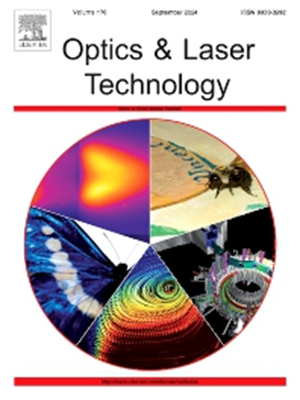Orthogonal-polarization-switching fiber laser using vernier-effect self-injection locking
IF 4.6
2区 物理与天体物理
Q1 OPTICS
引用次数: 0
Abstract
Vernier-effect self-injection locking is widely researched nowadays in frontiers of ultra-narrow linewidth lasers, owing to its simple design and independent of single frequency lasers. In this paper, for the first time we utilize this technology to realize an orthogonal-polarization-switching fiber laser, by a non-polarization-maintaining fiber laser (NPM-FL) self-injection locking to a high-Q fiber resonator (fiber-R). The NPM-FL is constructed in a mid-length linear cavity, with its longitudinal modes distributing in two orthogonal polarization and having a free spectral range (FSR) of 213 MHz. By selecting different single longitudinal mode (SLM) using the vernier-effect self-injection locking, orthogonal polarization switching of the locked NPM-FL is finally achieved. The orthogonal-polarization-switching fiber laser has a high polarization extinction ratio (PER) of ∼40 dB and an ultra-narrow spectral linewidth at ten-Hz level. This laser can be used in advanced sensing and LIDARs, where relative or differential measurements at two orthogonal polarizations are required.
求助全文
约1分钟内获得全文
求助全文
来源期刊
CiteScore
8.50
自引率
10.00%
发文量
1060
审稿时长
3.4 months
期刊介绍:
Optics & Laser Technology aims to provide a vehicle for the publication of a broad range of high quality research and review papers in those fields of scientific and engineering research appertaining to the development and application of the technology of optics and lasers. Papers describing original work in these areas are submitted to rigorous refereeing prior to acceptance for publication.
The scope of Optics & Laser Technology encompasses, but is not restricted to, the following areas:
•development in all types of lasers
•developments in optoelectronic devices and photonics
•developments in new photonics and optical concepts
•developments in conventional optics, optical instruments and components
•techniques of optical metrology, including interferometry and optical fibre sensors
•LIDAR and other non-contact optical measurement techniques, including optical methods in heat and fluid flow
•applications of lasers to materials processing, optical NDT display (including holography) and optical communication
•research and development in the field of laser safety including studies of hazards resulting from the applications of lasers (laser safety, hazards of laser fume)
•developments in optical computing and optical information processing
•developments in new optical materials
•developments in new optical characterization methods and techniques
•developments in quantum optics
•developments in light assisted micro and nanofabrication methods and techniques
•developments in nanophotonics and biophotonics
•developments in imaging processing and systems

 求助内容:
求助内容: 应助结果提醒方式:
应助结果提醒方式:


